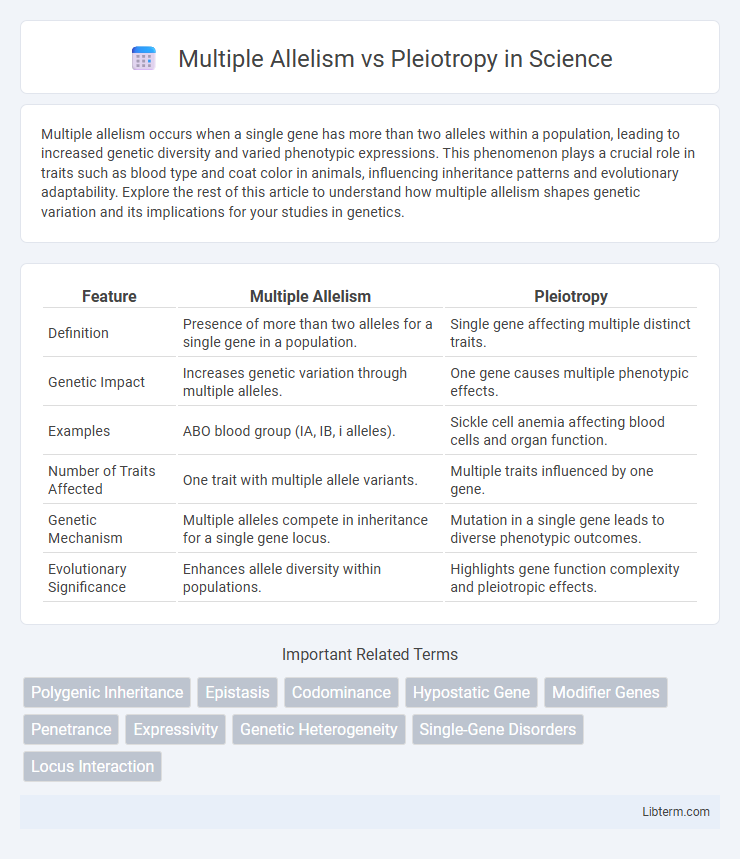Multiple allelism occurs when a single gene has more than two alleles within a population, leading to increased genetic diversity and varied phenotypic expressions. This phenomenon plays a crucial role in traits such as blood type and coat color in animals, influencing inheritance patterns and evolutionary adaptability. Explore the rest of this article to understand how multiple allelism shapes genetic variation and its implications for your studies in genetics.
Table of Comparison
| Feature | Multiple Allelism | Pleiotropy |
|---|---|---|
| Definition | Presence of more than two alleles for a single gene in a population. | Single gene affecting multiple distinct traits. |
| Genetic Impact | Increases genetic variation through multiple alleles. | One gene causes multiple phenotypic effects. |
| Examples | ABO blood group (IA, IB, i alleles). | Sickle cell anemia affecting blood cells and organ function. |
| Number of Traits Affected | One trait with multiple allele variants. | Multiple traits influenced by one gene. |
| Genetic Mechanism | Multiple alleles compete in inheritance for a single gene locus. | Mutation in a single gene leads to diverse phenotypic outcomes. |
| Evolutionary Significance | Enhances allele diversity within populations. | Highlights gene function complexity and pleiotropic effects. |
Introduction to Multiple Allelism and Pleiotropy
Multiple allelism refers to the presence of more than two alleles at a specific gene locus within a population, contributing to genetic diversity and variation in phenotypic traits. Pleiotropy occurs when a single gene influences multiple distinct phenotypic traits, often resulting from the gene's role in various biological pathways. Understanding multiple allelism and pleiotropy is essential for studying complex genetic inheritance patterns and the molecular mechanisms underlying trait expression.
Definitions: Multiple Allelism vs. Pleiotropy
Multiple allelism refers to the presence of more than two alleles at a single gene locus within a population, resulting in multiple phenotypic variations from different allele combinations. Pleiotropy occurs when a single gene influences multiple, seemingly unrelated phenotypic traits, demonstrating the gene's broad impact on an organism's physiology. Both concepts highlight different genetic mechanisms: multiple allelism emphasizes allele diversity, whereas pleiotropy underscores gene function versatility.
Genetic Basis of Multiple Allelism
Multiple allelism occurs when more than two alleles exist for a single gene locus within a population, providing a richer genetic diversity compared to simple Mendelian inheritance. The genetic basis of multiple allelism involves the presence of several variant forms or alleles of a gene, each potentially encoding different protein isoforms or regulatory sequences, resulting in varied phenotypic expressions. This contrasts with pleiotropy, where a single gene influences multiple phenotypic traits, highlighting the complexity of genetic variation and its impact on organismal traits.
Genetic Basis of Pleiotropy
The genetic basis of pleiotropy involves a single gene influencing multiple phenotypic traits, often through its diverse molecular functions or regulatory roles in different biological pathways. Multiple allelism refers to the presence of more than two alleles for a gene within a population, each potentially producing distinct phenotypic effects but limited to variations at one genetic locus. Unlike multiple allelism, pleiotropy demonstrates how a single gene's mutation can simultaneously affect various traits due to shared genetic or biochemical mechanisms.
Key Differences Between Multiple Allelism and Pleiotropy
Multiple allelism involves a single gene locus with more than two allelic forms influencing a trait, while pleiotropy occurs when one gene affects multiple distinct phenotypic traits. In multiple allelism, the genetic variation is confined to alleles of one gene, leading to different expressions of that trait, whereas pleiotropy shows how a single gene mutation can have widespread effects on an organism's physiology. Key differences also include the genetic basis: multiple allelism emphasizes allele diversity, whereas pleiotropy highlights gene impact breadth.
Examples of Multiple Allelism in Nature
Multiple allelism occurs when more than two alleles exist for a single gene within a population, exemplified by the ABO blood group system in humans where three alleles (IA, IB, and i) determine blood type. Another example includes the coat color in rabbits controlled by multiple alleles at the C locus, influencing pigmentation patterns from full color to albino. Multiple allelism enhances genetic diversity and allows for a range of phenotypic variations within species.
Examples of Pleiotropy in Nature
Pleiotropy occurs when a single gene influences multiple phenotypic traits, such as the Marfan syndrome gene affecting connective tissue, cardiovascular system, and eyes. Another example is the sickle cell gene, which impacts red blood cell shape, oxygen transport, and provides malaria resistance. Multiple allelism refers to a gene having more than two allele variants, unlike pleiotropy which involves one gene affecting multiple traits.
Phenotypic Effects and Expression Patterns
Multiple allelism involves a single gene with more than two alleles, each contributing distinct phenotypic variations within a population, resulting in diverse expression patterns. Pleiotropy occurs when one gene influences multiple, seemingly unrelated phenotypic traits, leading to complex and interconnected expression patterns across different tissues or functions. The key difference lies in multiple allelism producing variable effects on a single trait, while pleiotropy affects multiple traits through one gene's diverse functional roles.
Significance in Genetics and Evolution
Multiple allelism enhances genetic diversity within populations by allowing numerous alleles to exist at a single gene locus, increasing adaptability and evolutionary potential. Pleiotropy influences evolutionary trajectories by enabling a single gene to affect multiple phenotypic traits, potentially creating genetic correlations that impact natural selection and fitness. Understanding the roles of multiple allelism and pleiotropy is essential in genetics for predicting trait variability and in evolution for explaining complex trait development and constraint patterns.
Conclusion: Comparative Summary
Multiple allelism involves a single gene with more than two allelic forms influencing a particular trait, whereas pleiotropy occurs when one gene affects multiple phenotypic traits. Multiple alleles expand genetic diversity within a population, contributing to variations such as blood group systems, while pleiotropy highlights the interconnected impact of genes on complex biological processes and diseases. Understanding these genetic mechanisms clarifies the complexity of inheritance patterns and aids in genetic research and medical diagnostics.
Multiple Allelism Infographic

 libterm.com
libterm.com